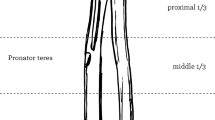Summary
Nonoperative management of forearm fractures in children has a good outcome in over 90 % of all cases. In our own series (n = 102) there were only six children (6.1 %) with significant limitation (> 25 °) of forearm rotation. In these cases two out of four (50 %) were located in the proximal third but only two out of 68 in the distal third. Indications for operative stabilization are the following: compound fractures, fractures associated with vessel and nerve injuries, joint fractures, dislocated fractures of the middle and proximal third, and Monteggia/Galeazzi injuries. As implants intramedullary devices are preferred. Twenty children were managed with elastic IM rods between 1994 and 1995 at our institution. At final follow-up all had a free ROM and a maximal axial malalignment of less than 5 °. In the region of the distal forearm K-wires are useful. Plates play a dominant role for corrections and nonunions; external skeletal stabilization is indicated for temporary fixation in compound fractures.
Zusammenfassung
Kindlichen Unterarmfrakturen heilen unter konservativer Therapie in über 90 % der Fälle mit gutem Ergebnis aus. Im eigenen Krankengut fanden sich unter 102 Kindern nur in 6 Fällen (6,1 %) signifikante Einschränkungen der Unterarmrotation (> 25 °). Diese traten bei 2 von 4 Patienten (50 %) mit proximal lokalisierter Fraktur, jedoch nur bei 2 von 68 Kindern (2,9 %) mit distal gelegener Fraktur auf. Frakturen mit schweren Weichteilschäden, Gefäß- und Nervenverletzungen, Gelenkbeteiligung, dislozierte Schaftfrakturen im mittleren und proximalen Drittel sowie Monteggia- und Galeazzi-Schäden werden operativ versorgt. Als Implantat sind beim Kind aller Altersstufen intramedulläre Implantate vorzuziehen. Zwischen 1994 und 1995 wurden in unserer Klinik 20 Kinder durch elastische Markraumschienung versorgt. Bei der Nachuntersuchung waren 16 Kinder mit uneingeschränkter Funktion beschwerdefrei. Bei keinem der Patienten wurde eine Achsabweichung von mehr als 5 ° festgestellt. Gelenknah können K-Drähte Anwendung finden, Plattenosteosynthesen kommen für Korrekturen und Pseudarthrosen in Betracht. Die externe Fixation als vorübergehende Ruhigstellung ist bei Weichteilschäden indiziert.
Similar content being viewed by others
Author information
Authors and Affiliations
Rights and permissions
About this article
Cite this article
Hahn, M., Richter, D., Muhr, G. et al. Forearm fractures in children Diagnosis, treatment, and possible complications. Unfallchirurg 100, 760–769 (1997). https://doi.org/10.1007/s001130050190
Published:
Issue Date:
DOI: https://doi.org/10.1007/s001130050190




